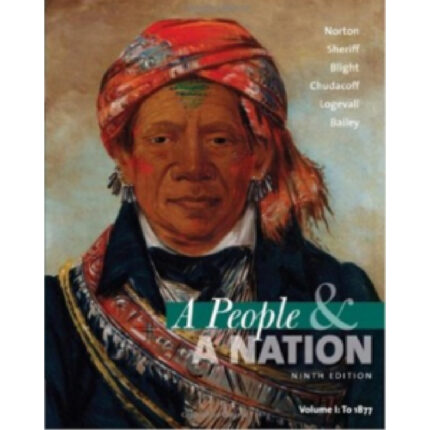Chapter 11 Cotton, Slavery, and the Old South
1) Which of the following statements about slavery in the North is accurate?
A) Northern states still technically allowed slavery through the antebellum period, though it had been eliminated in practice.
B) After 1787, the Northwest Territory became the last legal area for slavery in the North.
C) By 1804, the practice of slavery had been outlawed and strictly ended in all northern states.
D) Enslaved populations in the North during the colonial era reached as many as 100,000.
E) The North indirectly supported slavery all the way through the first half of the nineteenth century.
Answer: E
Topic: The Cotton Economy
Learning Objective: Explain how cotton, not industry, came to dominate the South.
Bloom’s: Understand
Accessibility: Keyboard Navigation
2) During the mid-nineteenth century, the center of economic power in the South
A) was in Charleston, South Carolina.
B) remained, as it had been, primarily within the upper South.
C) remained, as it had been, primarily within the lower South.
D) shifted from the lower South to the upper South.
E) shifted from the upper South to the lower South.
Answer: E
Topic: The Cotton Economy
Learning Objective: Explain how cotton, not industry, came to dominate the South.
Bloom’s: Remember
Accessibility: Keyboard Navigation
3) Tobacco cultivation in the antebellum South
A) was easy on the soil.
B) was gradually moving westward.
C) enjoyed a stable market.
D) was centered in the lower South.
E) never made a profit.
Answer: B
Topic: The Cotton Economy
Learning Objective: Explain how cotton, not industry, came to dominate the South.
Bloom’s: Remember
Accessibility: Keyboard Navigation
4) Rice and sugar production in the antebellum South
A) had short growing seasons.
B) were concentrated in a relatively small geographic area.
C) had difficulty sustaining profits for growers.
D) was in considerable decline by the 1850s.
E) threatened to overwhelm cotton production in the lower South.
Answer: B
Topic: The Cotton Economy
Learning Objective: Explain how cotton, not industry, came to dominate the South.
Bloom’s: Remember
Accessibility: Keyboard Navigation
5) Short-staple cotton
A) helped to keep the South a predominantly agricultural region.
B) was less coarse than long-staple cotton.
C) was easier to process than long-staple cotton.
D) was more susceptible to disease than long-staple cotton.
E) was only grown in the coastal regions of the upper South.
Answer: A
Topic: The Cotton Economy
Learning Objective: Explain how cotton, not industry, came to dominate the South.
Bloom’s: Remember
Accessibility: Keyboard Navigation
6) During the first half of the nineteenth century, the southern economy
A) was already losing ground to other staples, such as rice and tobacco.
B) saw wealthy planters outnumber small planters.
C) did not rely on large numbers of slaves imported directly from Africa.
D) came to rely on cotton as the dominant product.
E) still had not adopted the cotton gin, despite the time and resources that could be saved.
Answer: D
Topic: The Cotton Economy
Learning Objective: Explain how cotton, not industry, came to dominate the South.
Bloom’s: Remember
Accessibility: Keyboard Navigation
7) Between 1840 and 1860, the American South’s slave population
A) could not meet the South’s labor needs.
B) changed little.
C) dramatically shifted from the upper South to the cotton states.
D) declined in overall numbers.
E) became concentrated in the upper South.
Answer: C
Topic: The Cotton Economy
Learning Objective: Explain how cotton, not industry, came to dominate the South.
Bloom’s: Remember
Accessibility: Keyboard Navigation
8) By the time of the Civil War, cotton constituted nearly ________ of the total export trade of the United States.
A) one-fourth
B) one-tenth
C) one-third
D) half
E) two-thirds
Answer: E
Topic: The Cotton Economy
Learning Objective: Explain how cotton, not industry, came to dominate the South.
Bloom’s: Remember
Accessibility: Keyboard Navigation
9) By 1860, the textile manufacturing sector of the American South
A) was nonexistent.
B) had increased threefold in value over the previous twenty years.
C) had declined in value throughout the 1840s and 1850s.
D) was equal to one-third of the value of cotton exported that year.
E) had come to dominate the South’s economy.
Answer: B
Topic: The Cotton Economy
Learning Objective: Explain how cotton, not industry, came to dominate the South.
Bloom’s: Remember
Accessibility: Keyboard Navigation
10) The New Orleans magazine publisher, James D. B. De Bow, championed
A) southern economic independence from the North.
B) a turn away from industrial production in the South to further embrace agricultural strengths.
C) closer economic ties with the North.
D) southern economic independence from the North and a decreasing reliance on slavery.
E) closer economic ties with the North, and southern commercial and agricultural growth.
Answer: A
Topic: The Cotton Economy
Learning Objective: Explain how cotton, not industry, came to dominate the South.
Bloom’s: Remember
Accessibility: Keyboard Navigation













Reviews
There are no reviews yet.